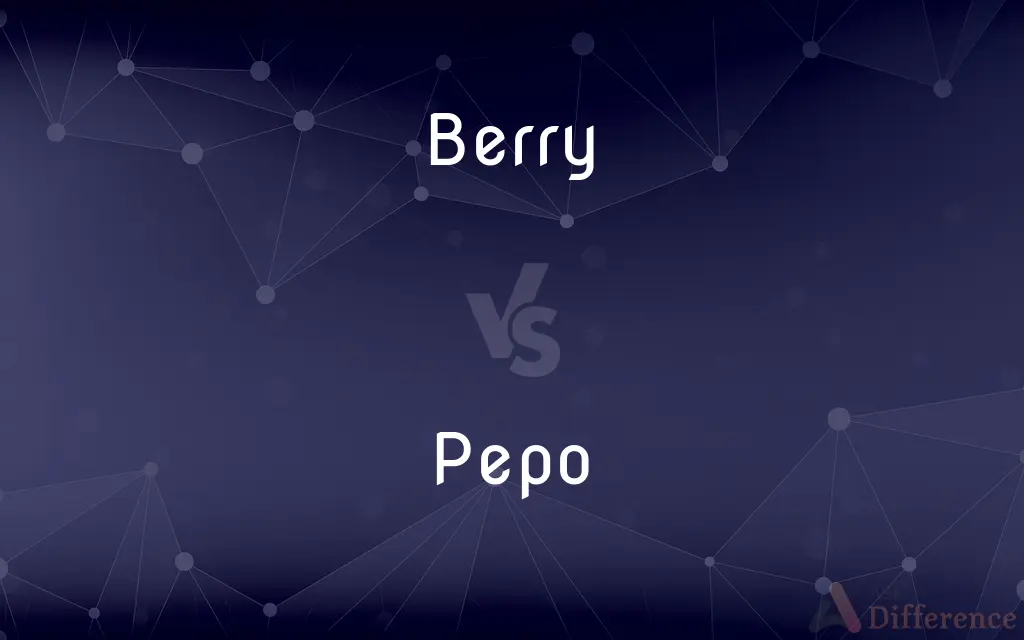Berry vs. Pepo — What's the Difference?
Edited by Tayyaba Rehman — By Urooj Arif — Updated on May 8, 2024
Berry is a fleshy fruit containing seeds, derived from a single ovary; whereas, a pepo is a specialized type of berry with a hard rind, like in cucumbers and melons.

Difference Between Berry and Pepo
Table of Contents
ADVERTISEMENT
Key Differences
A berry is a type of fruit that develops from the ovary of a single flower and typically contains several seeds. Whereas, a pepo is a specific subtype of berries characterized by a thick outer rind, which is not found in most other types of berries.
Berries come in various sizes and can be either soft or relatively firm, but they generally have a fleshy interior. On the other hand, pepos are distinguished by their harder, more durable outer skin which protects the soft flesh inside that houses the seeds.
In terms of botanical classification, all pepos are berries, but not all berries are pepos. While berries include a wide range of fruits like grapes, tomatoes, and blueberries, pepos specifically refer to fruits such as watermelons, cucumbers, and pumpkins.
Culinary usage of berries is quite diverse, often eaten fresh, in jams, or as part of desserts. Whereas, pepos are typically used in both sweet and savory dishes, depending on the type of fruit and its ripeness.
In gardening and agricultural contexts, berries are prized for their quick growth and often rich, vibrant colors which attract birds and other pollinators. On the other hand, pepos usually require a longer growing season and more space to develop, given their larger size.
ADVERTISEMENT
Comparison Chart
Definition
A fruit developed from a single ovary.
A type of berry with a hard rind.
Seed Enclosure
Seeds are embedded in the flesh.
Seeds are contained within a fleshy interior, protected by a hard rind.
Examples
Blueberries, grapes, tomatoes.
Watermelons, cucumbers, pumpkins.
Culinary Uses
Commonly used in jams, desserts, fresh eating.
Used in both sweet and savory dishes.
Growth Requirements
Shorter growing period, less space.
Longer growing period, more space needed.
Compare with Definitions
Berry
A fruit that is generally soft to the touch and sweet.
Grapes are versatile berries used in making wine.
Pepo
A berry with a hard outer rind and no internal segmentation.
Pumpkins are often carved as jack-o'-lanterns.
Berry
A small, pulpy fruit typically containing several seeds.
Strawberries and raspberries are popular types of berries.
Pepo
Typically grows on vines.
Cucumbers are pepos that are staple salad ingredients.
Berry
Commonly grown in temperate climates.
Blackberries thrive in cooler environments.
Pepo
Often larger and require more space to grow.
Watermelons are cultivated in warm regions.
Berry
Botanically, a fruit derived from a single ovary.
Tomatoes are technically berries.
Pepo
Has a protective rind that aids in longer shelf life.
Melons with their hard rind can be stored longer than many soft-skinned fruits.
Berry
Any small, colorful, and juicy fruit without a stone.
Blueberries are often used in desserts.
Pepo
Used in a variety of culinary dishes, from savory to sweet.
Squash is a pepo that can be roasted or turned into soup.
Berry
A berry is a small, pulpy, and often edible fruit. Typically, berries are juicy, rounded, brightly colored, sweet, sour or tart, and do not have a stone or pit, although many pips or seeds may be present.
Pepo
The fruit of any of various related plants, such as the cantaloupe, watermelon, cucumber, squash, pumpkin, and melon, having a hard or leathery rind, fleshy pulp, and numerous flattened seeds.
Berry
(Botany) An indehiscent fruit derived from a single ovary and having the whole wall fleshy, such as a grape or tomato.
Pepo
A fruit of plants of the gourd family Cucurbitaceae, possessing a hard rind and producing many seeds in a single, central, pulpy chamber.
Berry
A small, juicy, fleshy fruit, such as a blackberry or raspberry, regardless of its botanical structure.
Pepo
A plant producing such a fruit.
Berry
Any of various seeds or dried kernels, as of wheat.
Pepo
Any fleshy fruit with a firm rind, as a pumpkin, melon, or gourd. See Gourd.
Berry
One of the eggs of certain fishes or crustaceans, such as lobsters.
Berry
To hunt for or gather berries
Went berrying in July.
Berry
To bear or produce berries.
Berry
A small succulent fruit, of any one of many varieties.
Berry
(botany) A soft fruit which develops from a single ovary and contains seeds not encased in pits.
Berry
A coffee bean.
Berry
One of the ova or eggs of a fish.
Berry
A police car.
Berry
A dollar.
Berry
A mound; a barrow.
Berry
(dialectal) A burrow, especially a rabbit's burrow.
Berry
An excavation; a military mine.
Berry
To pick berries.
On summer days Grandma used to take us berrying, whether we wanted to go or not.
Berry
To bear or produce berries.
Berry
(transitive) To beat; give a beating to; thrash.
Berry
(transitive) To thresh (grain).
Berry
Any small fleshy fruit, as the strawberry, mulberry, huckleberry, etc.
Berry
A small fruit that is pulpy or succulent throughout, having seeds loosely imbedded in the pulp, as the currant, grape, blueberry.
Berry
The coffee bean.
Berry
One of the ova or eggs of a fish.
Berry
A mound; a hillock.
Berry
To bear or produce berries.
Berry
Any of numerous small and pulpy edible fruits; used as desserts or in making jams and jellies and preserves
Berry
A small fruit having any of various structures, e.g., simple (grape or blueberry) or aggregate (blackberry or raspberry)
Berry
United States rock singer (born in 1931)
Berry
Pick or gather berries;
We went berrying in the summer
Common Curiosities
What defines a berry?
A berry is defined as a fruit produced from the ovary of a single flower with seeds embedded in the flesh.
What is a pepo?
A pepo is a type of berry characterized by a hard rind and an interior that houses seeds, commonly found in the gourd family.
Why are berries important in a garden?
Berries attract birds and pollinators, adding vibrant color and biodiversity to gardens.
Can you give examples of berries?
Examples of berries include blueberries, tomatoes, and grapes.
How are berries used in cooking?
Berries are versatile in cooking, used in desserts, jams, and sometimes salads.
What makes pepos unique in the fruit family?
Their hard outer shell and lack of internal segmentation distinguish pepos from other types of fruit.
What are some typical pepos?
Typical pepos include cucumbers, pumpkins, and watermelons.
How does the growth of pepos differ from other berries?
Pepos generally require a longer growing season and more space due to their larger size.
What are the culinary uses of pepos?
Pepos are used in both savory dishes, like stews and salads, and sweet preparations, like melon balls in fruit salads.
Are all pepos considered berries?
Yes, in botanical terms, all pepos are considered berries, but they form a specific category with a hard rind.
Which berries are not pepos?
Most commonly recognized berries like strawberries, blueberries, and raspberries are not pepos.
Are there any berries that are commonly mistaken as non-berries?
Yes, fruits like bananas and avocados are technically berries, though not commonly classified as such in culinary contexts.
How do pepos contribute to biodiversity?
Pepos, like other members of the gourd family, play a vital role in ecosystems by providing food for wildlife and aiding in plant diversity.
What are the storage advantages of pepos over soft-skinned berries?
The hard rind of pepos offers advantages in storage, allowing them to be kept longer without spoilage compared to softer berries.
What is the botanical distinction between berries and pepos?
While all pepos are berries, the distinctive feature of pepos is their hard, protective outer rind.
Share Your Discovery

Previous Comparison
Traditional vs. Ethnic
Next Comparison
Super vs. DinnerAuthor Spotlight
Written by
Urooj ArifUrooj is a skilled content writer at Ask Difference, known for her exceptional ability to simplify complex topics into engaging and informative content. With a passion for research and a flair for clear, concise writing, she consistently delivers articles that resonate with our diverse audience.
Edited by
Tayyaba RehmanTayyaba Rehman is a distinguished writer, currently serving as a primary contributor to askdifference.com. As a researcher in semantics and etymology, Tayyaba's passion for the complexity of languages and their distinctions has found a perfect home on the platform. Tayyaba delves into the intricacies of language, distinguishing between commonly confused words and phrases, thereby providing clarity for readers worldwide.













































